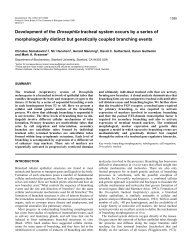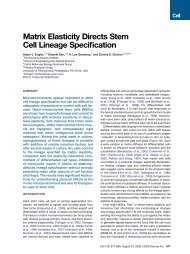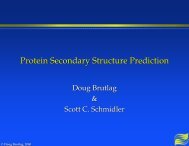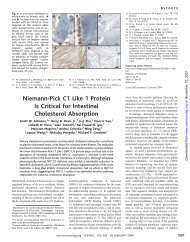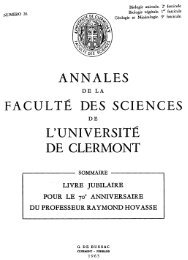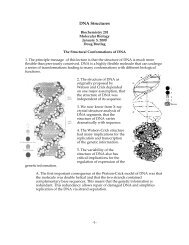Science 293 - Cmgm Stanford - Stanford University
Science 293 - Cmgm Stanford - Stanford University
Science 293 - Cmgm Stanford - Stanford University
Create successful ePaper yourself
Turn your PDF publications into a flip-book with our unique Google optimized e-Paper software.
Patterns of Gene Expression During Drosophila Mesoderm Development<br />
Eileen E. M. Furlong, 1 Erik C. Andersen, 1 * Brian Null, 1 Kevin P. White, 2 † Matthew P. Scott 1 ‡<br />
1 Departments of Developmental Biology and Genetics, Howard Hughes Medical Institute, Beckman Center B300, 2 Department<br />
of Biochemistry, 279 Campus Drive, <strong>Stanford</strong> <strong>University</strong> School of Medicine, <strong>Stanford</strong>, CA 94305–5329, USA.<br />
*Present address: Mail Stop 68-425 Department of Biology, Massachusetts Avenue, Cambridge, MA 02139, USA<br />
†Present address: Department of Genetics, Sterling Hall of Medicine, 333 Cedar Street, Yale <strong>University</strong> School of Medicine,<br />
New Haven, CT 06520, USA.<br />
‡To whom correspondence should be addressed. E-mail: scott@cmgm.stanford.edu<br />
The transcription factor Twist initiates Drosophila<br />
mesoderm development, resulting in the formation of<br />
heart, somatic muscle, and other cell types. Using a<br />
Drosophila embryo sorter, we isolated enough<br />
homozygous twist mutant embryos to perform DNA<br />
microarray experiments. Transcription profiles of twist<br />
loss-of-function embryos, embryos with ubiquitous twist<br />
expression, and wild-type embryos were compared at<br />
different developmental stages. The results implicate<br />
hundreds of genes, many with vertebrate homologs, in<br />
stage-specific processes in mesoderm development. One<br />
such gene, gleeful, related to the vertebrate Gli genes, is<br />
essential for somatic muscle development and sufficient to<br />
cause neural cells to express a muscle marker.<br />
Formation of muscles during embryonic development is a<br />
complex process that requires coordinate actions of many<br />
genes. Somatic, visceral, and heart muscle are all derived<br />
from mesoderm progenitor cells. The Drosophila twist gene<br />
(1), which encodes a bHLH transcription factor, is essential<br />
for multiple steps of mesoderm development: invagination of<br />
mesoderm precursors during gastrulation (2), segmentation<br />
(3), and specification of muscle types (4). The role of twist in<br />
mesoderm development has been conserved during evolution<br />
(5), perhaps because it controls conserved regulatory<br />
mesoderm genes. For example, tinman and dMef2 are<br />
regulated by Twist in flies (6, 7) (Fig. 1A) and are highly<br />
conserved in sequence and function in vertebrates (8–10).<br />
In Drosophila, somatic muscle forms from<br />
progenitor cells that divide to become muscle founder cells<br />
(11). Founder cells acquire unique identities controlled by<br />
transcription factors including Krüppel, S59, vestigial, and<br />
apterous. Each of the 30 body wall muscles in an abdominal<br />
hemisegment is initiated by a single founder cell and has<br />
unique attachments and innervations (12). To further clarify<br />
mechanisms underlying founder cell specification, myoblast<br />
fusion, and muscle patterning, we have used Drosophila<br />
mutants together with microarrays of cDNA clones.<br />
Transcription profile of twist homozygous mutant embryos.<br />
twist mutant embryos develop no mesoderm (1) [Web fig. 1<br />
(13)]. We compared the population of mRNA species isolated<br />
from twist homozygous embryos to that of stage-matched<br />
wild-type embryos. Drosophila lethal mutations are<br />
maintained as heterozygotes, in trans to balancer<br />
chromosomes. A twist mutation was established in trans to a<br />
balancer chromosome carrying a transgene encoding green<br />
fluorescent protein (GFP) (14). Embryos were collected from<br />
wild-type and twist/GFP-balancer fly stocks at specific<br />
developmental stages. The twist/GFP-balancer collections<br />
contain a mixed population of embryos; one-quarter twist<br />
homozygotes lacking GFP, half heterozygotes with one copy<br />
of GFP, and one-quarter homozygous for the balancer<br />
chromosome with two copies of GFP. Homozygous twist<br />
mutant embryos were separated from their siblings using an<br />
embryo sorter (15) [Web fig. 2 (13). Putative homozygous<br />
twist embryos were assessed by immunostaining with antidMef2<br />
antibody. More than 99% of the selected embryos had<br />
the twist phenotype.<br />
Three different periods of mesoderm development were<br />
analyzed: stages 9-10, 11, and 11-12 (stages according to<br />
(16)). During stage 9-10, the earliest time GFP is detectable<br />
in the balancer embryos (14), mesoderm cells migrate<br />
dorsally and become specified as somatic, visceral, cardiac,<br />
and fat body mesoderm. twist and its direct targets tinman and<br />
dMef2 are expressed throughout stage 9-10 mesoderm. The<br />
middle period contained stage 11 embryos and is a transition<br />
between the first period (stage 9-10) and the third period (late<br />
stage 11-12). During late stage 11 and stage 12, myoblast<br />
fusion begins and twist expression remains prominent in only<br />
a subset of the somatic muscle cells.<br />
For each developmental period, three independent embryo<br />
collections, embryo sortings, and microarray hybridizations<br />
were conducted. The microarrays used for the analysis<br />
contained over 8500 cDNAs corresponding to 5081 unique<br />
genes plus a variety of controls. Each embryonic RNA<br />
sample was compared to a reference sample, which contains<br />
RNA made from all stages of the Drosophila lifecycle and<br />
allows direct comparisons among all the experiments [See<br />
Web material for array and reference sample details (13)].<br />
Sample and array variability was determined by calculating<br />
correlation coefficients and standard deviations for each gene<br />
for all pair-wise combinations of repeated samples. The<br />
median correlation coefficient is 0.92 and median standard<br />
deviation/mean is 0.246 [See Web text for Validation<br />
information (13)].<br />
To determine how transcription was affected by the twist<br />
mutation, SAM (Significance Analysis of Microarrays)<br />
analysis was used (17). Genes that are normally highly<br />
expressed in mesoderm should have lower transcript levels in<br />
twist homozygotes. Genes in other tissues whose expression<br />
depends upon signals from the mesoderm might also have<br />
/ www.sciencexpress.org / 2 August 2001 / Page 1/ 10.1126/science.1062660
educed expression. Transcripts of 130 genes, the “Twistlow”<br />
group, were significantly lower in twist mutants than in<br />
wild type (Fig. 2A). Conversely, cells that would have formed<br />
mesoderm may take on other fates in the absence of twist,<br />
such as neuroectoderm, so many transcript levels could<br />
increase in twist mutants. Genes whose transcription is<br />
repressed by signals from the mesoderm would also be<br />
enriched in twist mutants. 150 genes, the “Twist-high” group,<br />
have increased levels of RNA in twist mutant embryos (Fig.<br />
2A).<br />
In total, 280 out of ~5000 genes had significant changes in<br />
transcript levels, with 10 false positives predicted (17) [See<br />
Web text for Validation information (13)]. The genes on the<br />
array include 15 previously characterized mesoderm-specific<br />
genes; all 15 were significantly reduced in twist mutant<br />
embryos (Fig. 3A). The arrays also contain genes known to<br />
be transcribed in both mesoderm and other cell types.<br />
Significant changes in expression were detected for many of<br />
these genes (Fig. 3B).<br />
The 130 Twist-low genes were divided into three groups<br />
(A, B, C) with similar trends of expression by a selforganizing<br />
map clustering program (Fig. 1B) (18). The 24<br />
group A genes, which included tinman, dMef2, and bagpipe,<br />
had reduced transcript levels in twist mutants at all<br />
developmental stages assayed. Most of the Twist-low genes<br />
fall into the B and C groups. The 62 group B “early-genes”<br />
encode transcripts with reduced levels of expression in twist<br />
mutants only during stages 9-10, not later. One member of<br />
group B, stumps (dof/hbr) is essential for mesoderm cell<br />
migration. stumps RNA is abundant in the mesoderm at<br />
stages 9-10 and strongly reduced by stage 11 (Fig. 1B) (19).<br />
At stage 11 stumps RNA accumulates in trachea, which are<br />
largely unaffected in twist mutants.<br />
The 44 group C genes have reduced transcript levels in<br />
twist mutant embryos only during late stage 11 and stage 12.<br />
These “late genes” include blown fuse, a gene essential for<br />
myoblast fusion (20), delilah, a gene required for somatic<br />
muscle attachment (21), and genes required to form<br />
contractile muscle, e.g. kettin (22). Given the predominantly<br />
early expression of twist, the early genes in groups A and B<br />
are the best candidates for direct transcription targets of<br />
Twist, though some indirectly activated genes may be present<br />
within these groups. Group C late genes are likely to be<br />
regulated by products of genes that are activated by Twist.<br />
In situ hybridizations were done using a previously<br />
uncharacterized representative of each Twist-low group (Fig.<br />
1C). In each case the hybridization pattern was consistent<br />
with the predicted time of transcription. A group A gene,<br />
CG15015 (GH16741), is transcribed in somatic muscle<br />
throughout stages 9-12. A group B gene, CG12177<br />
(GH22706), is transcribed during early mesoderm<br />
development, but not later. CG14848 (GH21860), a group C<br />
gene, is expressed in the stomodeum but not the mesoderm<br />
during stages 9-10. Its mesoderm expression initiates during<br />
stage 11, the latest period of the twist experiment. Combining<br />
loss-of-function mutant embryo analysis with staged embryo<br />
collections thus provides gene expression information for<br />
both tissue specificity and temporal expression.<br />
A complementary test: The transcription profile with twist<br />
over-expression. The mis-expression of twist in the ectoderm<br />
is sufficient to convert both neuronal and epidermal tissues to<br />
a myogenic cell fate (4). RNA from embryos with ubiquitous<br />
twist expression was used to evaluate the ability of Twist to<br />
initiate mesoderm-like gene expression in cells that would<br />
normally form other tissue types. Genes whose transcript<br />
levels decrease in twist loss-of-function embryos, and<br />
increase when twist is ubiquitous, are excellent candidates for<br />
regulators of mesoderm development or differentiation.<br />
To ectopically express twist a dominant gain-of-function<br />
mutation of the maternal gene Toll (Toll 10B ) was used (23).<br />
Activated Toll induces the expression of twist and snail in<br />
early embryos and immune response genes in older embryos<br />
(Fig. 1A) (24, 25). Thus, the effects of Toll 10B on gene<br />
expression reflect the activities of Twist as well as Snail and<br />
Dorsal, or their combined actions. Toll 10B embryos are<br />
essentially bags of mesoderm, do not produce any nervous<br />
tissue or ectodermal markers (23), and have been used<br />
successfully in subtractive hybridization screens to identify<br />
mesoderm genes (26). We compared the gene transcription<br />
profile of Toll 10B embryos to that of wild-type embryos during<br />
four periods of development, using the reference sample to<br />
normalize experiments. The earliest period, stage 5, is when<br />
twist is initially expressed in presumptive mesoderm. The<br />
other three periods analyzed were those used in the twist<br />
mutant analysis; stages 9-10, 11, and 11-12.<br />
In Toll 10B embryos 447 genes had significant changes in<br />
RNA levels compared to stage-matched wild-type embryos<br />
(Fig. 2A); 16 are predicted to be false positives (17) [See<br />
Web text for Validation information (13)]. Transcripts from<br />
166 genes were reduced in Toll 10B embryos compared to wild<br />
type. These genes may be involved in neuroectoderm events<br />
that are blocked when cells are turned into mesoderm (Fig. 2,<br />
clusters B, C). Transcripts of 281 “Toll-high” genes were<br />
increased in Toll 10B embryos. Of the 21 previously<br />
characterized mesoderm-specific genes on the arrays, 18 have<br />
significantly increased transcript levels in Toll 10B embryos<br />
(Fig. 3A). The remainder may require activators other than<br />
Toll, such as signals from the now non-existent ectoderm.<br />
Mesoderm and non-mesoderm gene classes. Genes with<br />
altered transcription in twist and Toll 10B mutants were<br />
analyzed with a hierarchical clustering program (27) to<br />
identify similar transcription profiles. The genes were divided<br />
into putative “mesoderm” and “non-mesoderm” groups (Fig.<br />
2A). Non-mesoderm genes were defined as having increased<br />
transcript levels in mesoderm-deficient (twist) embryos<br />
and/or decreased expression in mesoderm-enriched (Toll 10B )<br />
embryos (Fig. 2, B and C). Mesoderm genes were defined as<br />
having decreased transcript levels in twist mutants and/or<br />
increased transcripts in Toll 10B mutants (Fig. 2, D through F).<br />
The mesoderm genes group will also contain genes expressed<br />
in other tissues in a mesoderm-dependent manner.<br />
Non-mesoderm genes in clusters B and C are repressed in<br />
Toll 10B mutants. Cluster B (Fig. 2B) genes have increased<br />
RNA levels in twist mutant embryos while cluster C (Fig. 2C)<br />
genes do not change significantly. The overexpression of<br />
twist in the presumptive ectoderm in Toll 10B embryos results<br />
in a conversion of ectodermal cell fate into mesoderm. snail<br />
and dorsal are ectopically expressed in Toll 10B embryos (. 1A)<br />
and transcriptionally repress the expression of neuroectoderm<br />
and ectoderm genes (28, 29). The conversion of ectoderm to<br />
mesoderm due to twist mis-expression, and the ability of<br />
Snail and Dorsal to repress ectoderm genes, means the B and<br />
C clusters should contain primarily neuroectodermal genes.<br />
Indeed, the non-mesoderm genes include 31 previously<br />
characterized neuroectodermal genes. One novel cluster B<br />
gene that encodes a putative cell adhesion protein is<br />
transcribed in the ventral nerve cord (Fig. 2B). Another novel<br />
gene within cluster C is specifically transcribed within the<br />
developing brain (Fig. 2C).<br />
/ www.sciencexpress.org / 2 August 2001 / Page 2/ 10.1126/science.1062660
The Twist-low and Toll-high genes have in common 51<br />
genes (Fig. 2A) that are highly likely to be involved<br />
mesoderm development. For example, transcription of the<br />
genes in cluster D (Fig. 2D) is reduced in twist mutants and<br />
increased in Toll 10B mutants during most or all time periods.<br />
A complete overlap between Twist-low and Toll-high gene<br />
sets is not expected because: (i) Development of dorsal<br />
mesoderm, and of muscle founder cells marked by apterous<br />
and connectin, requires signals from the ectoderm:<br />
Decapentaplegic (a TGFβ-class signal) (30) and Wingless (a<br />
Wnt signal) (31). These signals are absent from Toll 10B<br />
embryos because ubiquitous twist and snail expression<br />
prevents ectoderm development. (ii) During midgut<br />
development endoderm cells migrate along the mesoderm.<br />
Midgut endoderm development is affected in twist mutants<br />
(32). Some Twist-low genes with unchanged expression in<br />
Toll 10B embryos are transcribed in the midgut (not shown).<br />
(iii) Ectopic Twist inhibits visceral mesoderm and heart<br />
development and promotes excess somatic muscle<br />
development (4). Toll 10B embryos produce high levels of<br />
Twist throughout the embryo, so genes that have reduced<br />
RNA levels in both twist and Toll 10B mutant embryos are<br />
likely to be visceral muscle and heart genes. Indeed bagpipe<br />
and connectin, genes expressed in visceral mesoderm, are<br />
among the 79 Twist-low genes not induced by ectopic Twist<br />
(Fig. 3A).<br />
Of the 281 Toll-high genes, 230 were unaffected in twist<br />
mutants. Some of the 230 are normally expressed late in<br />
embryogenesis in wild-type embryos but are expressed<br />
prematurely in Toll 10B embryos due to ectopic Twist. These<br />
include Myo61F, MSP-300, and Paramyosin, genes normally<br />
active in terminally differentiated muscle (stage 16) (Fig. 2F,<br />
Fig. 3A). Ectopic Snail and Dorsal in Toll 10B embryos may<br />
activate genes that are unaffected in twist mutants. Snail can<br />
repress neuroectodermal genes, and may also activate<br />
mesoderm genes (26). Dorsal activates immune response<br />
genes later in development (25). relish, drosomycin, and<br />
metchnikowin genes—all immune response genes—have<br />
higher transcript levels in Toll 10B embryos.<br />
Data from loss and gain-of-function experiments,<br />
combined with careful staging, yield a useful picture of genes<br />
that are likely to be required for mesoderm specification and<br />
muscle differentiation. Of 360 identified mesoderm genes,<br />
273 have not been the focus of developmental studies. The<br />
predicted proteins encode transcription factors, signal<br />
transduction molecules, kinases, and pioneer proteins. The<br />
stage at which each gene is active is one criterion for<br />
assigning possible functions. Another key criterion will be<br />
finding a mutant phenotype. As a pilot, we have taken this<br />
additional step for the gene CG4677 (LD47926). Changes in<br />
CG4677 transcript levels were also observed in a Toll 10B<br />
subtractive hybridization screen (26).<br />
gleeful, a gene required for somatic muscle development.<br />
CG4677 is transcribed in the visceral mesoderm at stages 10-<br />
11 and the somatic mesoderm during stages 11-13 (Fig. 4, A<br />
through C). This gene encodes a C2H2 zinc finger<br />
transcription factor with high sequence similarity to<br />
vertebrate Gli proteins so we have named the gene gleeful<br />
(gfl). Mammalian Gli proteins act downstream of Hedgehog<br />
signaling proteins to control target gene transcription (33).<br />
The role of gfl in mesoderm development was assessed by<br />
disrupting its function using RNA interference (34). Injection<br />
of a double-stranded RNA (dsRNA) control sequence had no<br />
effect on mesoderm development (Fig. 4D). In contrast gfl<br />
dsRNA injection caused severe loss and disorganization of<br />
somatic muscle cells (Fig. 4E), while heart and visceral<br />
muscle were unaffected (Fig. 4, E and F). A similar<br />
phenotype was seen in Df(3R)hh homozygous embryos (not<br />
shown), the deficiency removes gfl but not the nearby<br />
hedgehog gene<br />
To determine whether gfl can induce muscle cell<br />
development a UAS-gfl transgenic fly strain was generated.<br />
Ectopic expression of gfl using an en-GAL4 driver results in<br />
lethality and induction of ectopic dMEF2 expression in the<br />
ventral nerve cord (Fig. 4H). Remarkably, Gfl is sufficient to<br />
induce expression of a muscle gene in neuronal cells.<br />
Previous studies have shown an essential role for Sonic<br />
hedgehog signaling in the formation of slow muscle in avian<br />
and zebrafish embryos (35, 36). gfl may be performing a<br />
similar role in Drosophila somatic muscle development.<br />
This study has combined mutant embryo analyses with<br />
DNA microarrays to identify genes that are downstream of<br />
twist in mesoderm development. These efforts should be<br />
helpful in gaining a comprehensive view of cell fate<br />
determination, organogenesis, cell proliferation, and pattern<br />
formation in the mesoderm.<br />
References and Notes<br />
1. B. Thisse, M. el Messal, F. Perrin-Schmitt, Nucleic Acids<br />
Res 15, 3439 (1987).<br />
2. M. Leptin, B. Grunewald, Development 110, 73 (1990).<br />
3. O. M. Borkowski, N. H. Brown, M. Bate, Development<br />
121, 4183 (1995).<br />
4. M. K. Baylies, M. Bate, <strong>Science</strong> 272, 1481 (1996).<br />
5. J. Spring, et al., Dev Biol 228, 363 (2000).<br />
6. M. V. Taylor, K. E. Beatty, H. K. Hunter, M. K. Baylies,<br />
Mech Dev 50, 29 (1995).<br />
7. Z. Yin, X. L. Xu, M. Frasch, Development 124, 4971<br />
(1997).<br />
8. N. D. Hopwood, A. Pluck, J. B. Gurdon, Cell 59, 893<br />
(1989).<br />
9. C. Wolf, et al., Dev. Biol. 143, 363 (1991).<br />
10. S. M. Wang, et al., Gene 187, 83 (1997).<br />
11. M. V. Taylor, Curr. Biol. 10, R646 (2000).<br />
12. M. Bate, in The Development of Drosophila<br />
melanogaster, A. M. A. Michael Bate, Ed. (1993), vol. II,<br />
pp. 1013-1090.<br />
13. Web figures 1 through 3, Web table 1, and supplemental<br />
text are available at <strong>Science</strong> Online at<br />
www.sciencemag.org/cgi/content/full/1062660/DC1.<br />
14. D. Casso, F. Ramirez-Weber, T. B. Kornberg, Mech. Dev.<br />
91, 451 (2000).<br />
15. E. E. Furlong, D. Profitt, M. P. Scott, Nature Biotechnol.<br />
19, 153 (2001).<br />
16. J. A. Campos-Ortega, V. Hartenstein, The Embryonic<br />
Development of Drosophila melanogaster (Springer-<br />
Verlag, Germany, 1997).<br />
17. V. G. Tusher, R. Tibshirani, G. Chu, Proc. Natl. Acad.<br />
Sci. U.S.A. 98, 5116 (2001).<br />
18. P. Tamayo et al., Proc. Natl. Acad. Sci. U.S.A. 96, 2907<br />
(1999).<br />
19. S. Vincent, R. Wilson, C. Coelho, M. Affolter, M. Leptin,<br />
Mol. Cell. 2, 515 (1998).<br />
20. S. K. Doberstein, R. D. Fetter, A. Y. Mehta, C. S.<br />
Goodman, J. Cell. Biol. 136, 1249 (1997).<br />
21. P. Armand, A. C. Knapp, A. J. Hirsch, E. F. Wieschaus,<br />
M. D. Cole, Mol. Cell. Biol. 14, 4145 (1994).<br />
22. A. Lakey et al., EMBO J 12, 2863 (1993).<br />
23. D. S. Schneider, K. L. Hudson, T. Y. Lin, K. V.<br />
Anderson, Genes Dev. 5, 797 (1991).<br />
/ www.sciencexpress.org / 2 August 2001 / Page 3/ 10.1126/science.1062660
24. M. P. Belvin, K. V. Anderson, Annu. Rev. Cell. Dev. Biol.<br />
12, 393 (1996).<br />
25. I. Gross, P. Georgel, C. Kappler, J. M. Reichhart, J. A.<br />
Hoffmann, Nucleic Acids Res. 24, 1238 (1996).<br />
26. J. Casal, M. Leptin, Proc. Natl. Acad. Sci. U.S.A. 93,<br />
10327 (1996).<br />
27. M. B. Eisen, P. T. Spellman, P. O. Brown, D. Botstein,<br />
Proc. Natl. Acad. Sci. U.S.A. 95, 14863 (1998).<br />
28. M. Leptin, Genes Dev. 5, 1568 (1991).<br />
29. M. Levine, Cell 52, 785 (1988).<br />
30. M. Frasch, Nature 374, 464 (1995).<br />
31. X. Wu, K. Golden, R. Bodmer, Dev. Biol. 169, 619<br />
(1995).<br />
32. R. Reuter, B. Grunewald, M. Leptin, Development 119,<br />
1135 (1993).<br />
33. P. T. Chuang, T. B. Kornberg, Curr. Opin. Genet. Dev.<br />
10, 515 (2000).<br />
34. J. R. Kennerdell, R. W. Carthew, Cell 95, 1017 (1998).<br />
35. G. M. Cann, J. W. Lee, F. E. Stockdale, Anat. Embryol.<br />
(Berlin) 200, 239 (1999).<br />
36. K. E. Lewis, et al., Dev. Biol. 216, 469 (1999).<br />
37. We thank E. Johnson, M. Arbeitman, B. Baker, M. Siegal,<br />
R. Tibshirani, and V. Goss Tusher for statistical advice; B.<br />
Baker, F. Imam, and G. Zimmermann for careful<br />
manuscript reading; and M. Arbeitman, F. Imam, and E.<br />
Johnson for collaborating to prepare the reference sample.<br />
Support for E.F. by EMBO and <strong>Stanford</strong> Berry<br />
Fellowships, B.N. by NSF, and K.W. by Helen Hay<br />
Whitney fellowships. The research was supported by NIH<br />
grant K22 HG00045-02 (K.W.) and HHMI and DARPA<br />
grant MDA-972-00-1-0032 (M.S.).<br />
18 May 2001; accepted 23 July 2001<br />
Published online 2 August 2001;<br />
<br />
Include this information when citing this paper.<br />
Venn diagram shows the overlap between the twist and Toll<br />
experiments. The example clusters (B through F) are<br />
indicated by the colored bars in (A) and colored box around<br />
the corresponding cluster in B through F. A white line in the<br />
diagram between the twist and Toll experiments marks the<br />
transition in the clusters between the two genotypes.<br />
Examples of non-mesoderm gene clusters are shown in (B<br />
and C). Three representative clusters for mesoderm genes are<br />
shown in (D, E, and F). Red writing indicates either genes<br />
known to be transcribed in the nervous system and/or<br />
ectoderm [(B) and (C)] or known mesoderm genes [(D)<br />
through (F)]. One unknown gene (blue writing) from each<br />
cluster was selected for in situ hybridization. Scale bars in (B)<br />
through (F) are 39 µm.<br />
Fig. 3. (A) Changes in gene expression in twist and Toll 10B<br />
embryos compared to wild type for all known mesodermspecific<br />
and muscle genes on the array. stumps was placed in<br />
this group as it is primarily expressed in the mesoderm during<br />
these stages. (B) Gene expression data for genes both in the<br />
mesoderm and other tissues.<br />
Fig. 4. Gleeful (Gfl), is essential for somatic muscle<br />
development. (A through C) In situ hybridization of gfl<br />
(CG4677, LD47926). gfl is expressed transiently in the<br />
visceral mesoderm (red arrow) and somatic mesoderm (green<br />
arrow) from stages 10-13. (D) Embryos injected with a<br />
control double-stranded RNA and immuno-stained with α-<br />
dMef2 antibody. (E) Embryos injected with double-stranded<br />
RNA for gfl (from LD47926 cDNA) and immuno-stained<br />
with α-dMef2. There is a severe loss of somatic muscle cells<br />
[green arrows in (D) and (E)]. (F) Same embryo shown in (E)<br />
focusing on visceral mesoderm (blue arrow). The heart<br />
[arrowheads in (D) and (E)] and visceral mesoderm appear<br />
normal. (G) Ventral view of a wild-type stage 16 embryo<br />
stained with α-dMef2. (H) Embryo containing UAS-gfl and<br />
en-GAL4 stained with α-dMef2. Ectopic expression of gfl<br />
induces dMef2 expression in the ventral nerve cord (black<br />
arrow). dMef2-expressing cells are embedded within the<br />
ventral nerve cord [inset in (H), high magnification]. Scale<br />
bars are 39 µm.<br />
Fig. 1. Gene expression profiles in twist mutant embryos<br />
compared to wild-type embryos. (A) Twist is at the top of a<br />
transcriptional hierarchy in mesoderm development and<br />
directly regulates the expression of tinman, dMef2, and itself.<br />
(B) A self-organizing map clustering program divided the 130<br />
Twist-low genes into 3 groups with similar trends in<br />
expression (18). This analysis was done in log 2 using a 3x1<br />
matrix and converted back to real numbers to graph the data.<br />
0.5 represents a 2-fold reduction in twist embryos compared<br />
to wild type. Increasing the complexity of the SOM matrix<br />
subdivides these subgroups further (e.g. 3x2 matrix), but the<br />
general trends remain the same. Graph lines represent average<br />
transcription changes for all genes within that group. Web<br />
table 1 (13) shows the results of the SOM program using<br />
genes within groups A through C. (C) In situ hybridization<br />
with one unknown gene from each group in B. Scale bars in<br />
(B) through (F) are 39 µm.<br />
Fig. 2. A comparison of gene expression profiles of<br />
mesoderm-deficient (twist mutant) and mesoderm-enriched<br />
(Toll 10B mutant) embryos. (A) 643 genes had significantly<br />
changed transcription in twist and Toll mutant embryos<br />
compared to wild-type. Ratios of mutant/wild-type were<br />
arranged with a hierarchical clustering program (13, 27). The<br />
/ www.sciencexpress.org / 2 August 2001 / Page 4/ 10.1126/science.1062660



